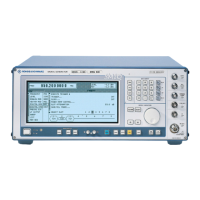Vector Modulation SMIQ
1125.5555.03 E-82.66
2.8 Vector Modulation
In the vector modulation mode (I/Q modulation) external modulation signals can be applied to
modulation inputs I and Q for a complex modulation of the RF carrier.
ï
ð
SMIQ
I = 0.3 V
Q = 0.4 V
I
Q
IQ
V
22
05
+
,
x
input value LEVEL
Amplitude =
Fig. 2-33 Example: vector modulation
If the I/Q modulator is driven by a constant sum vector modulation of
IQ V
22
05+=. the actual RF
level corresponds to the displayed RF level. To avoid the I/Q modulator being overdriven, care should
be taken that the sum vector never exceeds 0.5 V when digital modulation modes with amplitude
modulation components such as QPSK are used. For full-scale input, the peak envelope power of the
modulated RF signal is thus equal to the indicated LEVEL. The average power is smaller. The
difference can be entered as an offset in the LEVEL menu.
Vector modulation settings are accessible in the VECTOR MOD menu, see following page.
Note: - Types of modulation VECTOR MOD and BB-AM cannot be set at the same time; they
switch each other off.
- A selectable internal calibration of the I/Q modulator allows accurate and reproducible
measurements to be made. The calibration routine should be called up with the
CALIBRATE
in the menu VECTOR MOD or UTILITIES-CALIB-VECTOR MOD after
temperature changes of more than 5° C.

